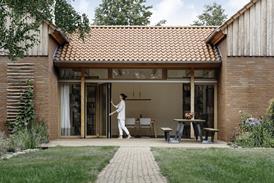Trisha Shirt, Agency liaison officer
Trisha Shirt started working for Notting Hill Housing Trust in October 1973. It then owned just 1541 homes and employed 70 people to buy and refurbish slums owned by private landlords before letting them to the poor and homeless of west London.
Over three decades, she’s seen the trust go from a fundraising stall in Portobello market to a 19,000-unit behemoth with more than 700 staff.
“It was very much a case of ‘suck it and see’ 30 years ago; you didn’t have manuals or procedures or protocols, whereas nowadays you’re more professional,” she says. “There was more freedom then: you’d go out and try and do something and if it worked, it worked.
“You’d see a gap, and fill it,” she says, referring to Notting Hill’s first foray into shared ownership in 1979 with community leaseholds.
Shirt got interested in housing when she did a week’s work experience at Sheffield council’s housing department while she was at university. She joined Notting Hill as a housing assistant on £1500 a year and worked in development and research before settling in supported housing in 1987.
“One of the first shocks when I came to the trust was the standard of the homes – I’d never seen slum housing before. We bought houses that had gas lighting, that didn’t have electricity.
“It was staggering the way people lived, making the best they could out of it.”
Shirt’s first duty was collecting rent over the local housing office counter and, once a week, from six elderly tenants in their homes.
“That was very nice. You went round and had a cup of tea with each tenant.”
Shirt’s next job was in the development department, where from 1976 to 1982 she experienced the trust’s rapid expansion from the front line of North Kensington.
“We were churning out more than 700 units a year – at times it felt like a sausage machine. It was mostly about refurbing street properties, rather than estates. In those days, that was how development happened – there were very few new-build schemes.”
Without the vast resources it has today, Notting Hill’s development staff had a very different challenges.
“We used to rely a lot on volunteers,” Shirt recalls. “Once, I sweet-talked my boss into letting a couple go into a flat over a weekend to decorate; I came in on Monday to find they’d left me a message saying the ceiling had collapsed – I didn’t dare tell the boss for a week!”
Shirt also remembers the social workers in the trust’s welfare department, set up in 1972. “We used to do things like having curtains made for tenants and getting them put up, and arrange for removal vans – we don’t do that these days.
“At one point, the trust was accused of patronising its tenants, but we did provide a service that a lot of people benefited from. Over the years, how we deliver that service has changed. We’ve made people part of it. You didn’t have concepts like that in 1973.”
Eileen Gordon, NHHT tenant since 1972
“I almost jumped out of my shoes – I was so eager to say yes,” says Eileen Gordon, remembering the day in 1972 when she was first asked whether she would be happy for Notting Hill Housing Trust to take over her home.
One of the trust’s first housing officers, Sam Hood, had knocked on her door and explained that the trust was thinking of buying the block of flats in which she lived in – it was then owned by notorious slum landlord Peter Rachman.
The trust buying my home from Peter Rachman was the best thing that happened since I came to this country
Eileen Gordon
“It was the best thing that has happened to me since I came over from the Caribbean. When he went out through the gate, I shouted after him ‘make sure you buy this property!’”
Gordon, her husband and their four children were sharing a flat in Colville Gardens, Ladbroke Grove, with two rooms, a kitchen with a bath in it and no heating.
She had lived in some appalling places since she came to west London from Jamaica in the 1950s.
“Things were very hard for people like us: most landlords didn’t want West Indians.
“We’d heard about Notting Hill Housing Trust but it seemed like it was only privileged people who were getting housed by the council,” she says. “But then I started seeing people like me being rehoused in places that were just so much better than mine so it started to seem more real – and that was magnificent.”
As with all of the 1500-odd slum properties it had bought from private landlords since it was set up, Notting Hill began to refurbish the block.
“I had to move away temporarily because it was in a very bad state.
“They put me in a flat in Westbourne Park and I stayed there for eight months – each day I used to visit the house to see how it was getting on.”
The family moved back into a much larger flat on the ground floor and basement. For less rent – £2.20 a week – they had four bedrooms, a living room, a kitchen, a bathroom, a washroom and coal heating.
Coal was a common feature of the trust’s earliest refurbishments, and one of the least popular. “When I came home in the evening, there’d be smoke all over the place because you had to stoke it up before you went to work to keep it going through the day,” recalls Gordon. “One day I heard they were changing them, but the trust said it couldn’t afford it to do mine.
“So I said: ‘Suppose you lend me the money, let me have a heating change-over and I pay you back?’. They said yes.”
Gordon also remembers the trust stepping in in the mid-1970s when she was finding it hard to pay the household bills.
“Things were pretty bad: my husband had had a heart attack and I wasn’t earning a lot. I had a gas bill for £27 and an electricity bill for £4.20 and the trust paid them both for me. “They weren’t very big bills, but at that time it was an awful lot for me.”
Being a housing association tenant had other benefits, particularly with the introduction of secure tenancies. “Living in a housing trust property is like living in your own place. There’s no one to bother you.
“When I lived in a Rachman flat, they had a man who would come in once a month. They wanted to see what the place was like but there was nothing to see – they didn’t give us any furniture, there was nothing in the place. We had to even find our own bed and bath.
“With the housing trust you have a nice bath, a basin, a toilet and it’s for you and your family alone. It’s private. When you find yourself in a sticky place and someone gets you out, it’s good.”
Source
Housing Today

















No comments yet